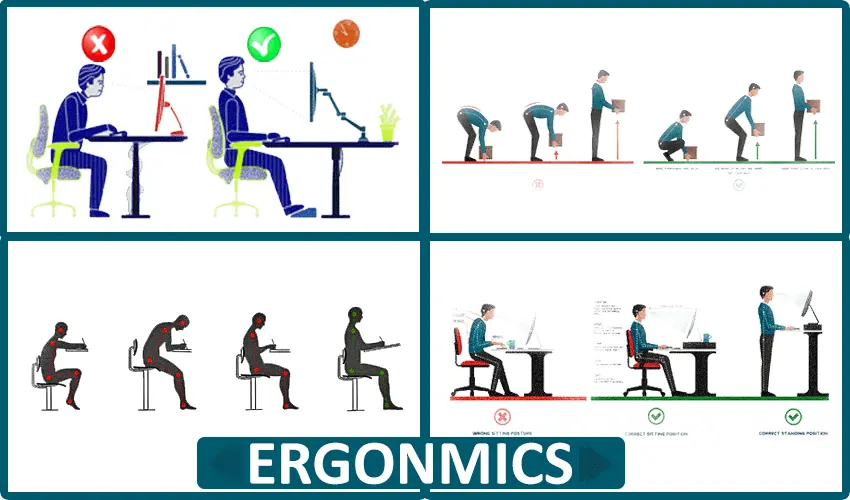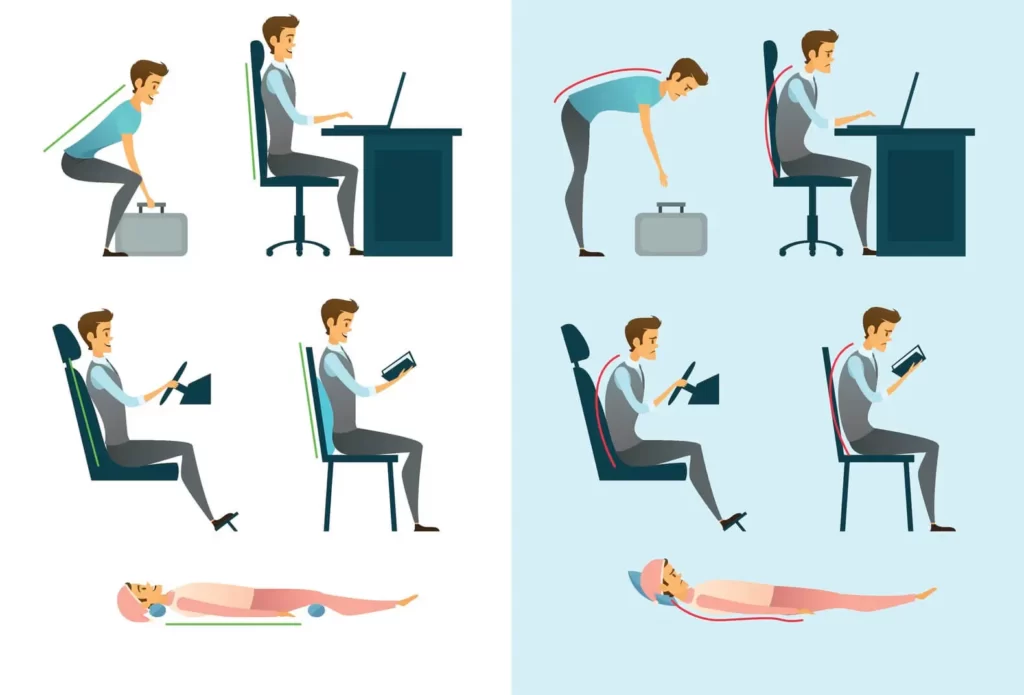Ergonomics is the science of designing the workplace to fit the worker, promoting efficiency, comfort, and well-being. The “Principles of Ergonomics” are the core guidelines that underpin this field, directing how work environments should be constructed to minimize strain, reduce the risk of injury, and boost productivity. These principles apply across various industries, from office settings to manufacturing floors, influencing not only the physical layout of the workspace but also the tools, equipment, and practices employed.
This blog will explore the 10 fundamental ergonomics principles essential for creating a healthy and efficient work environment. By understanding and applying these principles, employers, and employees can contribute to a more comfortable, safe, and productive workplace. Whether you are an office manager looking to improve staff well-being or a worker interested in enhancing your comfort and efficiency, these principles offer valuable insights for everyone in the working community.
10 Basic Principles Of Ergonomics
Ergonomics is more than just a buzzword in modern workplace design; it’s a comprehensive approach that focuses on aligning the work environment with the capabilities and limitations of the human body. By understanding and implementing the 10 principles of ergonomics, organizations can create a work environment that fosters comfort, safety, efficiency, and well-being. Here’s a detailed look at these vital principles:
1. Work in Neutral Postures
Maintaining neutral postures is about preserving the body’s natural alignment, which helps to reduce physical stress. A neutral posture means the joints are naturally aligned, minimizing the strain on the muscles, ligaments, and tendons. Keeping the spine in an ‘S’ shape and aligning the neck, hands, and wrists correctly can prevent undue tension on the muscles.
Using ergonomic furniture, like chairs with proper lumbar support, adjustable desks, and specially designed keyboards, is crucial in achieving this alignment. Regular assessments and adjustments to the work environment and employee training on maintaining proper posture are also essential to prevent long-term musculoskeletal disorders.

2. Reduce Excessive Force
Excessive force, particularly in manual labor tasks, can cause acute injuries and chronic joint and muscle issues. This principle emphasizes the need to identify tasks that might require excessive physical effort and modify them. This could mean automating certain processes, providing machinery to carry heavy loads, or redesigning tasks to require less force.
Providing ergonomically designed tools to fit the user’s hand can also reduce the need for excessive gripping or pinching. Training in proper lifting techniques and using mechanical aids can further reduce the risk of overexertion injuries.
3. Keep Everything in Reach
This principle stresses the importance of workspace layout. If objects are placed too far away, workers may need to stretch, reach, or twist their bodies in ways that can cause strain over time. The key here is to design workspaces where all necessary tools and materials are within arm’s reach. This might involve reorganizing shelves and drawers, using adjustable trays, or customizing workstations for individual employees.
Regularly reviewing workspace layouts and soliciting employee feedback on their needs and comfort can help maintain an accessible work environment.
4. Work at the Proper Height
Working at an inappropriate height can lead to discomfort and injury, whether seated or standing. A work surface too high may force the shoulders and arms into an elevated position, causing strain. If it’s too low, it might lead to slouching or bending, putting pressure on the back. Adjustable furniture, footrests, and platforms are key to achieving height.
Employers should also consider the specific tasks being performed and the physical stature of individual workers. Regular training and evaluation are needed to ensure employees understand how to adjust their workspaces to suit their needs.
5. Reduce Excessive Motions
Repetitive motions, especially forceful or awkward ones, can lead to musculoskeletal disorders over time. This principle focuses on identifying tasks that require repetitive movements and finding ways to reduce them. This can be achieved through job rotation, using different muscles, and implementing automation or mechanical aids to carry out repetitive tasks.
Ergonomic tools that fit the hand’s natural contours can also minimize strain. Providing training on proper techniques and encouraging regular short breaks to relieve muscle tension are crucial strategies for reducing the risks associated with excessive motions.
6. Minimize Fatigue and Static Load
Fatigue occurs when muscles are used repetitively without sufficient rest, leading to decreased performance and possibly injury. The static load is the strain on muscles and joints when holding a position or carrying weight for extended periods. Managing fatigue involves providing sufficient rest breaks, allowing muscles to recover, and ensuring that workstations are designed to support the body properly.
Task rotation can help distribute the workload more evenly across different muscle groups. Ergonomic supports like adjustable chairs and wrist rests can also alleviate strain. Encouraging team lifting for heavy objects can spread the load and reduce the risk of injury.
7. Minimize Pressure Points
Pressure points are areas where the body’s weight presses against a surface, leading to discomfort or health problems over time. For example, hard seating surfaces can create pressure points at the base of the spine, while poorly designed desk heights can lead to pressure on the wrists or forearms.
Utilizing ergonomic chairs with proper cushioning, adjusting desk heights, and using anti-fatigue mats are practical solutions. Awareness and continuous assessment of these pressure points are essential to creating a comfortable work environment, as everyone’s body is unique.

Also Read
What Is Ergonomics? Types Of Ergonomics And Examples
Understand ergonomics, its types, and examples. Learn how ergonomic practices improve comfort, efficiency, and health in various settings.
8. Provide Clearance
Clearance refers to having enough unobstructed space for people to move freely without the risk of bumping or tripping. A workspace cluttered with objects can hinder movement and lead to accidents. Ensuring clear walkways, providing proper storage for tools and equipment, and keeping cords or cables neatly organized are some ways to provide clearance. Designing spaces with enough room for all workers, including those with disabilities, helps create an inclusive and safe environment.

9. Move, Exercise, and Stretch
Sitting or standing in the same position for long periods can lead to stiffness and discomfort. Encouraging movement, exercise, and stretching can improve circulation, flexibility, and overall well-being. Employers can facilitate this by offering stretching guides, providing space for movement, and even implementing exercise programs or stretch breaks during the day.
Incorporating adjustable sit/stand desks and promoting a culture that values health and mobility also contributes to this effort.
10. Maintain a Comfortable Environment
Comfort extends beyond physical positioning to include the entire working environment. Proper lighting is essential to avoid eye strain and headaches, so adjusting task lighting and minimizing glare is beneficial. Temperature control, through air conditioning or heating, ensures the environment is neither too hot nor too cold.
Attention to air quality, such as proper ventilation and air filtration, can prevent respiratory issues. Even aesthetic elements like color and decor can affect mood and productivity. Regular evaluation and adjustments to these environmental factors, considering individual preferences, can create a comfortable and efficient workspace.
These intertwined principles contribute to an ergonomic workspace that supports physical health, enhances productivity, and fosters a positive work culture. Implementing these principles requires ongoing attention, regular assessments, and a commitment to accommodating the workforce’s diverse needs. By prioritizing these principles, employers can create a work environment that is not only safe and comfortable but also conducive to higher job satisfaction and overall well-being.
Conclusion
The 10 fundamental principles of ergonomics provide a comprehensive framework for designing and organizing workspaces that prioritize workers’ comfort, health, and efficiency. By following these guidelines, organizations can create environments that reduce the risk of physical strain and injury and enhance overall productivity and job satisfaction. Implementing these principles requires a commitment to continuous assessment, employee involvement, and adaptation to individual needs and preferences.
Ultimately, the principles of ergonomics are more than just a set of guidelines; they represent a philosophy that places the well-being of the workforce at the center of organizational design and practice. Embracing the 10 fundamental principles of ergonomics is an investment in human capital that pays dividends in the form of a happier, healthier, and more engaged workforce, contributing to the long-term success of any organization.

